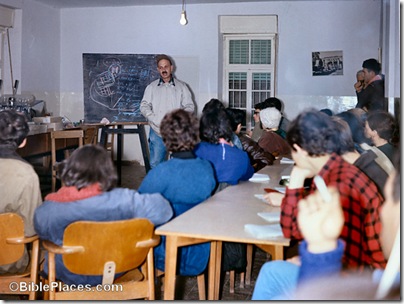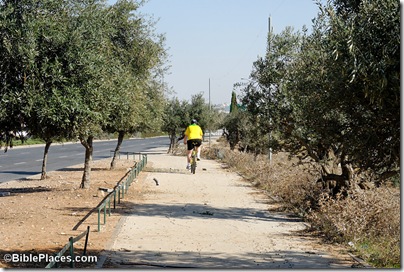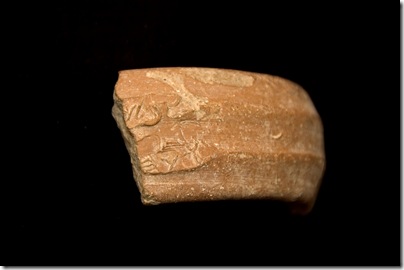One thing (an important thing) to consider when choosing an excavation to join is the extra-curricular activities. By that I mean the evening lectures and the afternoon or weekend tours. Digging in the dirt is nice, but your experience will be greatly enhanced if you can learn about your site and travel around the area. Having said that, and having looked at the schedule at Gath this season, I would certainly recommend choosing Gath for your excavation next year. Check the schedule out at the Gath blog. A tip to other excavations interested in boosting their number of volunteers for future seasons: put your extra-curricular schedule online. And start a dig blog.
Arutz-7 reports on an up-coming bike ride in Israel:
From September 21-27, 2008, athletic tourists will be able to visit and tour the country in a unique style: Bicycling their way through the upper Galilee and the Golan Heights on the Jewish National Fund’s first annual Bike Ride Mission to Israel. “Participants will traverse over 200 miles of breathtaking terrain,” the JNF literature announces, “during four days of fully supported riding (all ability levels are welcome), and will be rewarded with exclusive accommodations at the 5-star Mitzpe Hayamim Hotel and Spa and The Carmel Forest Spa Resort.” The bicycle tours will include stops in towns, army bases, and JNF sites such as security bypass roads, forests, and nature reserves. The participants will also hear talks from public officials and IDF officers, will learn about Israel’s water problems and the JNF’s efforts and successes in solving them, and will take part in rafting and wine-tasting activities. The cost: $3,600 per rider (double occupancy), not including airfare. Participants can either bring their own bicycle or rent one here…. For more information on the bike mission, visit www.jnf.org/bikeisrael.
- Tagged Galilee, Opportunities
From the Jerusalem Post:
An IDF training exercise sparked a massive wildfire at the Ein Fasha Nature Reserve Tuesday morning, destroying nearly 2000 dunams [500 acres] of land in what the chief firefighter on the scene called “the largest wildfire of the summer.” “It’s by far the largest,” said Amnon Amir of the Judea and Samaria Fire Department, as flames in the area were still being sprayed by airplanes overhead. “It started around four in the morning, and has been extremely difficult to put out.” According to Amir, the exceedingly dry conditions in the area, which borders the northern Dead Sea, added to the difficulty, and low amounts of rainfall over the winter were to blame. But he also told The Jerusalem Post that the IDF had initially prevented his firefighters from entering the area, making it more difficult to combat the intense flames…. “It will take 10 years before the area completely renews itself,” Nissim said. “But within six months or so, we’ll already see new signs of life. This isn’t a completely tragedy, because it’s somewhat healthy for the vegetation to renew itself like that, but still, it’s been difficult to watch it all burn.” The army refused to comment further on the incident, which Army Radio reported had begun from a flash or smoke grenade. According to the Judea and Samaria fire department, there were no injuries reported, and damage was limited to the plant life in the reserve. There have been three large wildfires throughout the country since Saturday, two in the Jerusalem Hills before Tuesday’s at Ein Fasha. Firefighters blame high temperatures and dry conditions as a factor in all of the fires, but at least one, on Saturday afternoon near Kibbutz Ma’aleh Hahamisha, was reportedly the result of arson.
- Tagged Dead Sea
This AP article is about American archaeology, but the technology could be applied to the Near East, if it hasn’t been already.
You might be surprised what you can learn from a campfire. A campfire that has been cold for, say, 300 years.
Stacey Lengyel hopes she can tell, within 30 years or so, when it was used.
Lengyel, a research associate in anthropology at the Illinois State Museum, is the country’s leading authority on archeomagnetic dating, a process built around two phenomena: when heated, magnetic particles reorient themselves to magnetic north; and over time, magnetic north is, literally, all over the map.
“They call it a ‘drunken wander,’ ” said Lengyel. “Around 1600, it was real close to Earth’s rotational axis. Now, it is around 75 degrees latitude….”
In archeomagnetic dating, once potential samples have been identified, their location and orientation are precisely measured, Lengyel said. About a dozen 1-inch cubes are then excised, encased to preserve them, then taken to a lab.
The chunks are then progressively demagnetized until their natural remnant magnetism can be measured, she said. The objects may have been partially magnetized by nearby lightning strikes, for example, or if they were stored near objects with strong magnetic fields. These weaker magnetic fields must be removed.
First their magnetic fingerprint is taken, and then they are slightly demagnetized. The process is repeated several times; eventually all that is left is the baseline magnetic signal, she said. If the material is fired to about 500 degrees Celsius or more, the magnetic field will point to where magnetic north was located at the time.
“The best dates we can get are within a 30-year time period,” Lengyel said.
The complete article is here.
HT: Joe Lauer
- Tagged Technology
Last month I was in Israel when a friend called and said that one of the students in a group he was leading found a jar handle with a LMLK seal impression laying on the ground at Ramat Rahel (two miles south of the Old City of Jerusalem). I’ve led student groups around Israel for 15 years and none of them has ever found a LMLK handle and my friend is three days into his first trip when one is found. Within a day or so, he had sent a photo of the seal impression to “Mr. LMLK” (who immediately published an analysis of it here) and got the expert opinion of Dr. Gabriel Barkay.
Yesterday, the story made it into the newspaper. If you’re recruiting for next year’s tour, you can try enticing your students with the hope of such a discovery. And you might take a closer look at that next potsherd before you toss it.
- Tagged Discoveries, Jerusalem
My impression that there were too many tourists in Israel last month was correct. In fact, there has never been more tourists in the history of the nation. Haaretz reports:
Nearly 300,000 tourists visited Israel in May, an all-time record, the Ministry of Tourism said.
The number of tourists was five percent higher than May of 2000, Israel’s record year for tourism, and at the current pace, 2.8 million tourists are on track to visit by the end of the year, according to the ministry….
By 2012, the ministry’s goal is to attract five million tourists, have 220,000 workers employed in the tourism industry and have tourism revenues of NIS 43 billion.
Goals are good, but it might be wise for the budgeters to keep in mind that 5 months after Israel’s record-breaking May 2000, tourism nearly ground to a halt for about 3 years.
If the optimists are right, you’re best to avoid the month of May in future years if possible. You know it’s going to be bad when there are no seats left for your group’s flight in a year in advance (that’s my situation for next May). Here are some advantages to going in other months:
- February: no tourists (but potentially lots of rain)
- March: everything is green and wildflowers are everywhere
- August: no tourists (but you’ll know why as you hesitate to get off the air-conditioned bus)
- October: possibly my favorite month of the year in Israel, with great temperatures and no rain
- December: clearer air (less haze) means better panoramic views
- Tagged Travels
Search
About the BiblePlaces Blog
The BiblePlaces Blog provides updates and analysis of the latest in biblical archaeology, history, and geography. Unless otherwise noted, the posts are written by Todd Bolen, PhD, Professor of Biblical Studies at The Master’s University.
Subscribe
Tags
10th Century
American Colony Photos
Analysis
Antiquities Trade
Dead Sea
Dead Sea Scrolls
Discoveries
Egypt
Excavations
Forgery
Galilee
Greece
Holidays
Israel's Coast
Italy
Jerusalem
Jezreel Valley
Jordan
Jordan Rift
Judah
Lebanon
Lectures
Mediterranean Islands
Mesopotamia
Museums
Negev
New Exhibits
Persia
Philistines
Photo Resources
Picture of the Week
Pseudo-Archaeology
Resources
Sad News
Samaria
Shephelah
Syria
Technology
Temple Mount
Tomb of Jesus
Tourism
Travels
Turkey
Weather
Weekend Roundup
Links
Notice
As an Amazon Associate we earn from qualifying purchases. In any case, we will provide honest advice.



